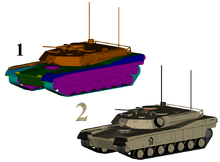
Appaloosa
The Appaloosa is an American horse breed best known for its colorful spotted coat pattern. There is a wide range of body types within the breed, stemming from the influence of multiple breeds of horses throughout its history. Each horse's color pattern is genetically the result of various spotting patterns overlaid on top of one of several recognized base coat colors. The color pattern of the Appaloosa is of interest to those who study equine coat color genetics, as it and several other physical characteristics are linked to the leopard complex mutation (LP). Appaloosas are prone to develop equine recurrent uveitis and congenital stationary night blindness; the latter has been linked to the leopard complex.
Artwork depicting prehistoric horses with leopard spotting exists in prehistoric cave paintings in Europe. Images of domesticated horses with leopard spotting patterns appeared in artwork from Ancient Greece and Han dynasty China through the early modern period; the Nez Perce people of what today is the United States Pacific Northwest developed the original American breed. Appaloosas were once referred to by settlers as the "Palouse horse", possibly after the Palouse River, which ran through the heart of Nez Perce country. Gradually, the name evolved into "Appaloosa".

Wide Prairie
Wide Prairie is a posthumous compilation by Linda McCartney. The album was compiled and released in 1998 by Paul McCartney after his wife's death, after a fan wrote in enquiring about "Seaside Woman"; a reggae beat type song which Wings had recorded in 1972, under the name Suzy and the Red Stripes, featuring Linda on lead vocals. Her husband compiled all her recordings with the help of Parlophone Records and MPL Communications. Lead guitar on the song "The Light Comes from Within" is played by the McCartneys' son, musician/sculptor James McCartney. The album reached number 127 in the UK charts, while the title track made the top 75, at number 74. "The Light Comes from Within" also charted, at number 56 in the UK charts.
Track listing
All songs by Linda McCartney, except where noted.
- Recorded by Wings on 20 November 1973 in Paris, and in June 1974 in Nashville, Tennessee.
- Linda McCartney – Lead vocals, Mellotron, Backing vocals
- Paul McCartney – Bass, Piano, Rhodes, Electric organ, Backing vocals
- Jimmy McCulloch – Electric guitar
- Denny Laine – Acoustic guitar
- Davey Lutton – Drums
- Vassar Clements and Johnny Gimble – Fiddles
- Thaddeus Richard – Alto saxophone
- Hewlett Quillen – Trombone
- William Puett – Tenor saxophone
- George Tidwell and Barry McDonald – Trumpets
- Norman Ray – Baritone saxophone
Appaloosa (band)
Appaloosa is a band composed of lyricist/vocalist Anne-Laure Keib and musician Max Krefeld. The pair met when Anne-Laure left her native Paris to spend time in Berlin, and together they formed Appaloosa there in June 2006.
Keib writes the lyrics and serves as the band's vocalist and front-woman. Krefeld writes the music which frequently involves programming and the use of synthesizers.
Appaloosa's song, "The Day (We Fell in Love)" appeared on Kitsuné Maison Compilation 6, released by Kitsuné Music in October 2008.
In the latter part of 2008, Keib’s longtime friend and former roommate Chan Marshall invited Appaloosa to support Cat Power on a US tour.
In February 2009, Kitsuné Music released "The Day (We Fell in Love)" as a 12" single, with remixes by house music producer Todd Edwards and the LA based Acid Girls. Around the same time photographer Patrick O'Dell created a video for the original version of the song.
On May 2014 she supported Cat Power Solo tour throw Europe.
References
Texture
Texture may refer to:
Science and technology
- Texture (roads), road surface characteristics with waves shorter than road roughness
Arts
Music
See also

Texture (painting)
Texture in painting is the look and feel of the canvas. It is based on the paint, and its application, or the addition of materials such as ribbon, metal, wood, lace, leather and sand. The concept of 'painterliness' also has bearing on texture. The texture stimulates two different senses; sight and touch. There are four types of texture in art: actual texture, simulated texture, abstract texture, and invented texture.
Actual texture
This is a combination of how the painting looks, and how it feels to the touch. It is associated both with the heavy buildup of paint, such as an impasto effect, or the addition of materials.
Simulated texture
Creating the visual effect of texture without actually adding texture. For instance, a texture created to look like something other than paint on a flat surface. An example is Cataract 3, painted in 1967 by Bridget Riley, which creates the illusion of ripples in the paper through the repetition of lines.
Implied texture
Texture that does not directly represent the object it is connected with but the concept of the object is translated in textural patterns.

Texture mapping
Texture mapping is a method for adding detail, surface texture (a bitmap or raster image), or color to a computer-generated graphic or 3D model. Its application to 3D graphics was pioneered by Edwin Catmull in 1974.
Originally a method that simply wrapped and mapped pixels from a texture to a 3D surface - now more technically called diffuse mapping to distinguish it from more complex mappings - in recent decades the advent of multi-pass rendering and complex mapping such as height mapping, bump mapping, normal mapping, displacement mapping, reflection mapping, mipmaps, occlusion mapping, and many other complex variations on the technique have made it possible to simulate near-photorealism in real time, by vastly reducing the number of polygons and lighting calculations needed to construct a realistic and functional 3D scene.
Podcasts:

